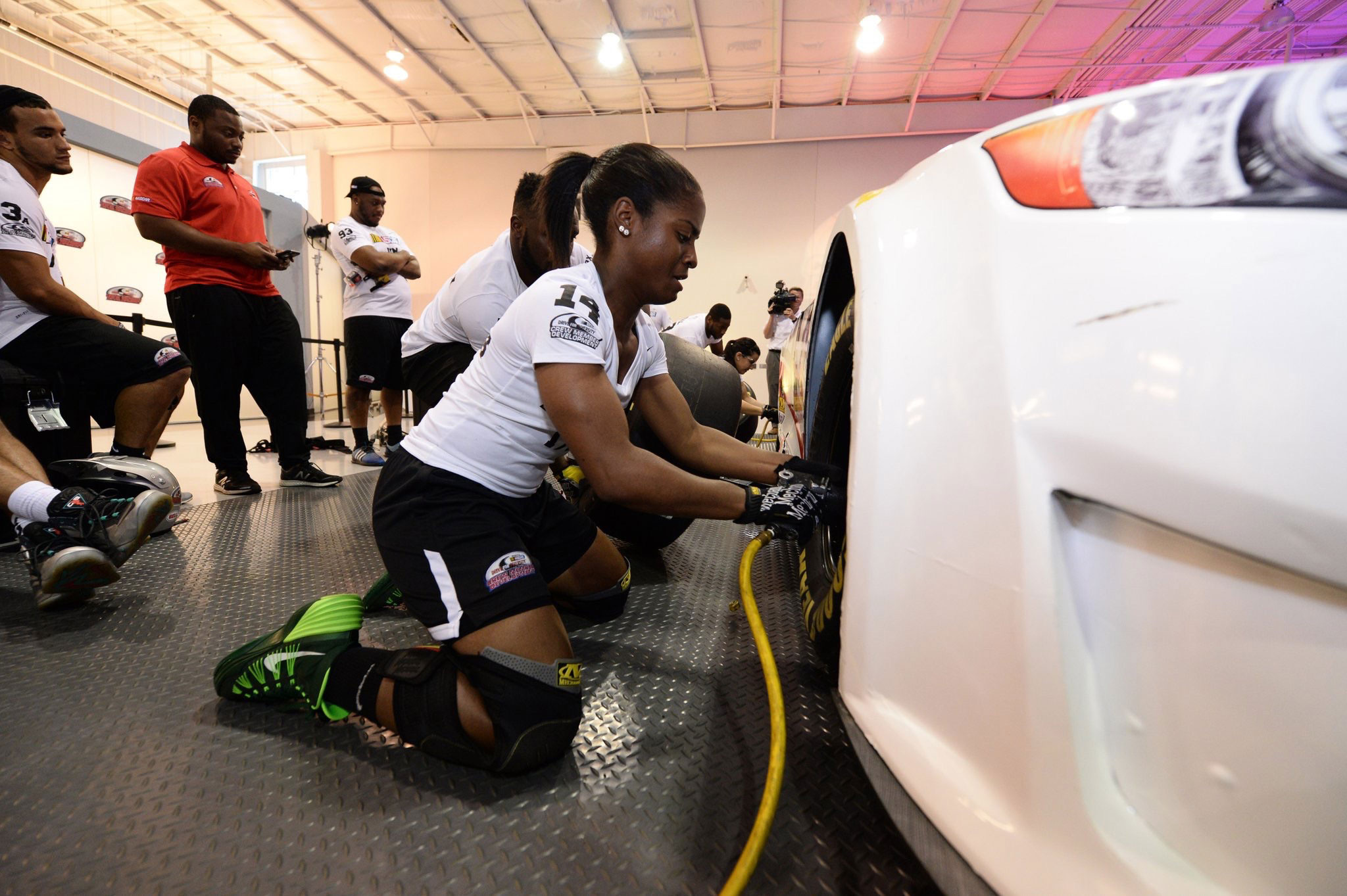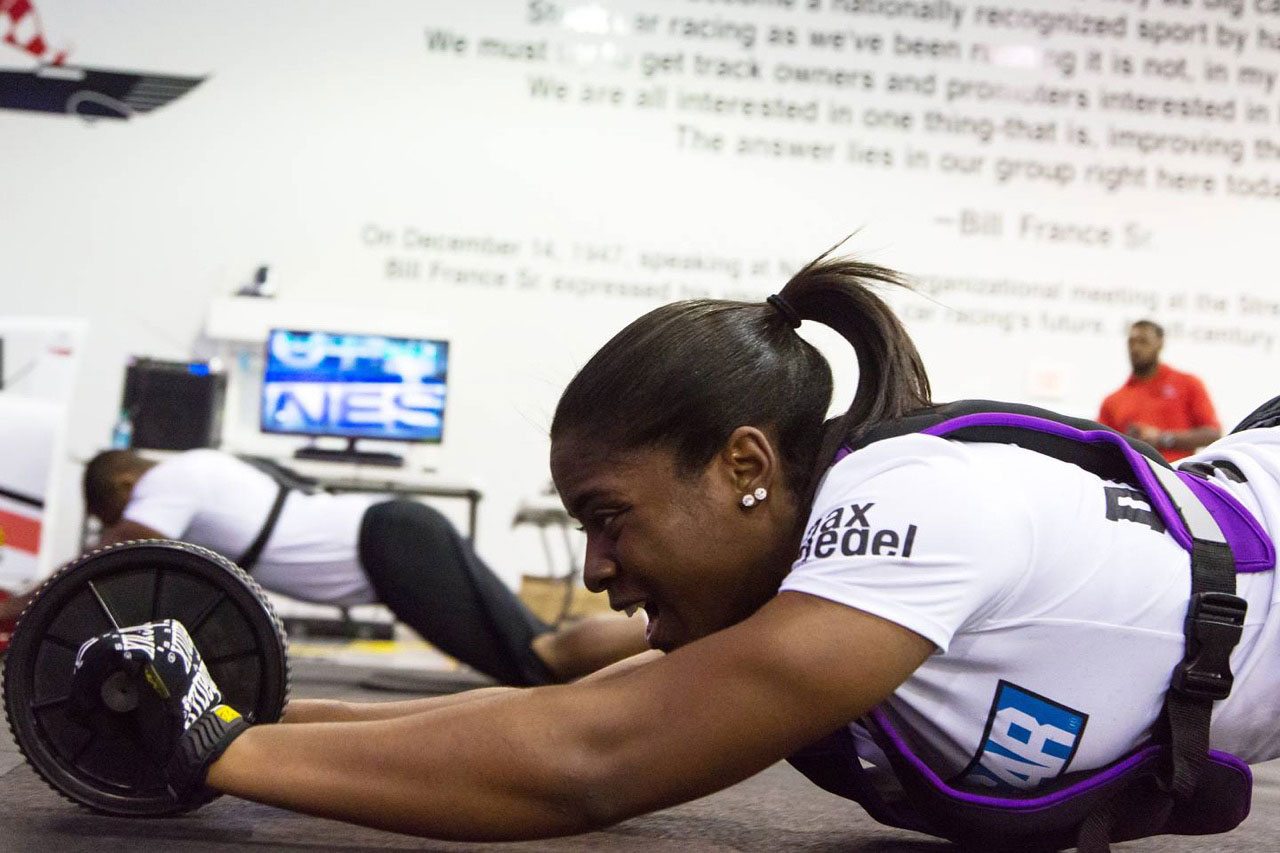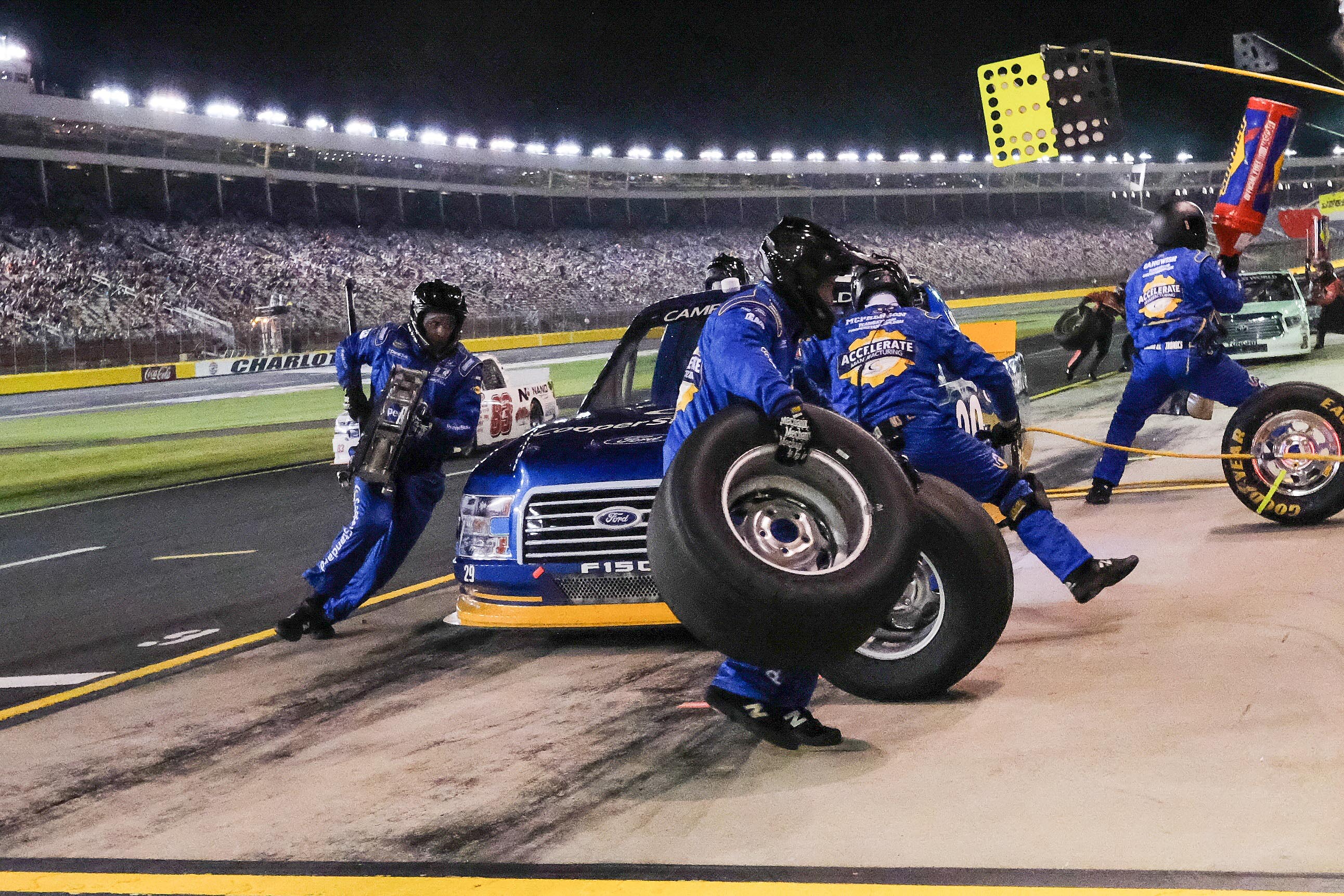Last month, at Nashville’s Fairgrounds Speedway, the Automobile Racing Club of America (ARCA) held its first race of the 2017 season. Four hours before the event, under a blue sky, fans began streaming into the grandstands as the 34 drivers put their cars through inspections and qualifying drills. The pit crews, meanwhile, went through their own preparation, cleaning tires, preparing lug nuts, testing hydraulic jacks, and checking their air guns.
For 23-year-old Brehanna Daniels, the day was especially memorable because it was her first professional race as a tire changer. She walked over to her assigned driver, Dale Shearer, a friendly, white, 51-year-old Missourian, who stood beside his car in his fire suit and sunglasses. When he saw her approaching—her gear bag and helmet under her arm, an “Xcalibur Pit School” T-shirt over her muscular, compact frame—his lips stretched into a welcoming smile.
Videos by VICE
“You must be Brehanna,” he said.
It’s hard to mistake Brehanna Daniels for anyone else at the raceway—she’s one of the only women of color in a sport that is still predominantly white and male. Should Daniels continue to rise through the ranks, from ARCA to stock-car racing’s big leagues, she would become the first African-American female pit crew member in NASCAR history, and a success story for the company’s Drive for Diversity program. Since it began in 2004, Drive for Diversity has produced three professional minority male drivers, and eleven professional female pit-crew members, including Daniels, the only African-American.

“A top-notch pit crew runs about 11.5 seconds.” Courtesy Brehanna Daniels
“[At the Speedway], people were looking at me, like, ‘What does she do? I know she does something because she has that bag,’” Daniels said from her home in Charlotte, North Carolina. “Then, when I went to the bathroom to change into my fire suit, I really had looks on me…. A photographer who was there stopped taking pictures of the drivers and started shooting me.”
Still, Daniels wasn’t intimidated by the stares, even though they came from a crowd of virtually all white men. The reason, she said, was that she’d already found everybody in the sport to be fully supportive, exhibiting no racism or sexism whatsoever.
Coaches from NASCAR’s Drive for Diversity program recruited Daniels last year, when she was a senior at Norfolk State University, the historically black college in her home state of Virginia. She’d played Division I basketball at NSU, but had no prospects on the pro level. So when she found out that NASCAR was coming to campus, looking for female athletes and athletes of color, she decided to give it a shot.
“I didn’t watch NASCAR races growing up. I always thought, Dang, there’s no black people in the sport,” she said. “But I’m always open to new opportunities, and I didn’t have anything else to do, so I went out for the tryout.”
The audition was designed to simulate the physical demands of working in the pit, where speed, agility, strength, and footwork are all necessary to perform, be it as a tire changer or carrier, jack man or gas man. Phil Horton, Drive for Diversity’s director of athletic performance, realized several years ago that athletes, rather than mechanics, make the best pit crew members.
At NSU, Daniels was up against eight other student-athletes, all of whom were men, most of whom were football players. But being the lone woman in the pack only added fuel to her fire. Like most athletes, she thrives on pressure—and the adrenaline that comes it.
“We started off with a hundred jump ropes and then we moved to a cone drill,” she explained. “Then we moved to a ladder drill. The ladder was so tough that we got to practice before being timed for real. Then we did rollout abs, then pushups, and then we had to finish it off with a hundred sit-ups. The guy I was next to, I was destroying him. I had him beat since the jump rope. He had to take a break. I think he caught a cramp. I was like, ‘Yeah!’”
Horton couldn’t help but notice Daniels as she tore through the military-style obstacle course. It was obvious she had the physical prowess and psychological makeup of a seasoned athlete. What’s more, at five-foot-five, she had the ideal frame for a tire-changer, a position that requires speed and hand-eye coordination more than size.

Daniels during the national combine. Courtesy Brehanna Daniels
“We liked her skills, we liked her style, we liked her strength,” he said from his office in Charlotte. “We liked the fact that she had a leadership role as a point guard on the basketball team. She just fit the template.”
NASCAR invited Daniels to the national combine in Charlotte, where she competed with twenty other pit crew candidates and made the cut by placing in the top ten.
“I liked doing it because it reminded me of being an athlete,” she said. “We athletes crave that feeling of knowing you’re competing against someone. You just love being in situations where you’re under pressure and you have to get the job done.”
Daniels moved to Charlotte to begin a six-month program for pit-crew members run by the Drive for Diversity. There, she trained six hours a day, five days a week, learning to operate the tools and getting up to pit speed. Her hands were so sore after the workouts that she soaked them in ice water every night.
Daniels is now a professional tire-changer, working independently. She’ll continue in the program for another two or three years, training three days a week at a track, in tandem with daily workouts at the gym, where she does bench presses, rowing exercises, weighted squats, and hundreds of sit-ups to boost her strength and performance.
That preparation came in handy at the ARCA race in Nashville. When Shearer pulled into the pit at the mandatory 45 miles an hour, Daniels jumped off the wall and ran out to the car, an air gun in hand and a fresh 65-pound tire under her arm. As cars flew by on the track at over 100 miles an hour, she dropped to her knees and hit the back tire’s lug nuts with the air gun. She pulled the tire off using her index and middle fingers, and set it aside, careful to not let it roll. Then she grabbed the fresh tire, slammed it on the rim, and gunned the lug nuts. After racing to the other side of the car, she repeated the process. Her time for removing and replacing both tires: 13.5 seconds.
“A top-notch pit crew runs about 11.5 seconds,” Horton said. “Right now, Brehanna is about two seconds behind. Not bad after only eight or nine months of training.”

A NASCAR pit crew in action earlier this month. Photo by Jim Dedmon-USA TODAY Sports
Daniels’ goal is only partly to cut her time and make history by becoming the first African-American woman in a NASCAR pit. She also wants the validation, not to mention the six-figure salary that can come with working the elite races in NASCAR’s Cup Series.
“To get to the very, very top series, it will take some time,” she said. “They say give it three or four years, but I’m trying to get there in under three. I’m impatient, as most athletes are.”
Coach Horton says Daniels is exactly where she should be in her quest.
“She’s starting in the ARCA series. That’s where everybody starts. Then she’ll move up to the Camping World Truck Series, which is a NASCAR series, and if she has the talent, will move up from there.”
Does Horton think she has the talent?
“We selected her,” he said. “We don’t bring someone in if we feel they can’t do it. We expect her to make it to the Cup Series. She definitely has what it takes.”
Horton repeatedly pointed to Daniels’s drive, which her family continues to stoke. Her father, Luxley, a hospital supervisor and NSU alum, at first was leery of having his daughter working in such a risky environment, afraid she’d be hit by a runaway car while working the pit. According to Coach Horton, when taking into account all the racing series, at least one crew member is brushed or bumped by a car every week. “It’s no small feat to get the job done and survive,” he said. But once Luxley saw his daughter’s determination, he got fully behind her, and is thrilled that she’s on the verge of breaking an historic barrier.
Daniels’s mother, Kimberly, lost a battle with cancer nine years ago, but Daniels has no doubt she would have been supportive, too.
“My mother would be like, ‘Brehanna, what are you thinking doing this?’” Daniels said. “But she always believed in me. My mom motivates me. Whenever I think about giving up, I always think about her.”
As for the ARCA race, Dale Shearer failed to finish. He had a problem with his car and left the track after thirty laps. Before doing so, he made sure to stop in the pit twice, giving Daniels the practice she needed.
Now she can’t wait for her next race. Through it all, she’s grateful to the diversity program for opening NASCAR’s doors for her.
“It’s a great thing to get more people of different ethnicities and different races involved in the sport, and to have everyone feel that they’re welcome,” she said. “It’s not just one face, it’s multiple faces.”
When asked what she would say to young girls who might think about following her into the pit, Daniels enthusiastically shared her personal philosophy. “You can do everything you put your mind to. It doesn’t matter what other people think. Seize every opportunity.”
Want to read more stories like this from VICE Sports? Subscribe to our daily newsletter.




